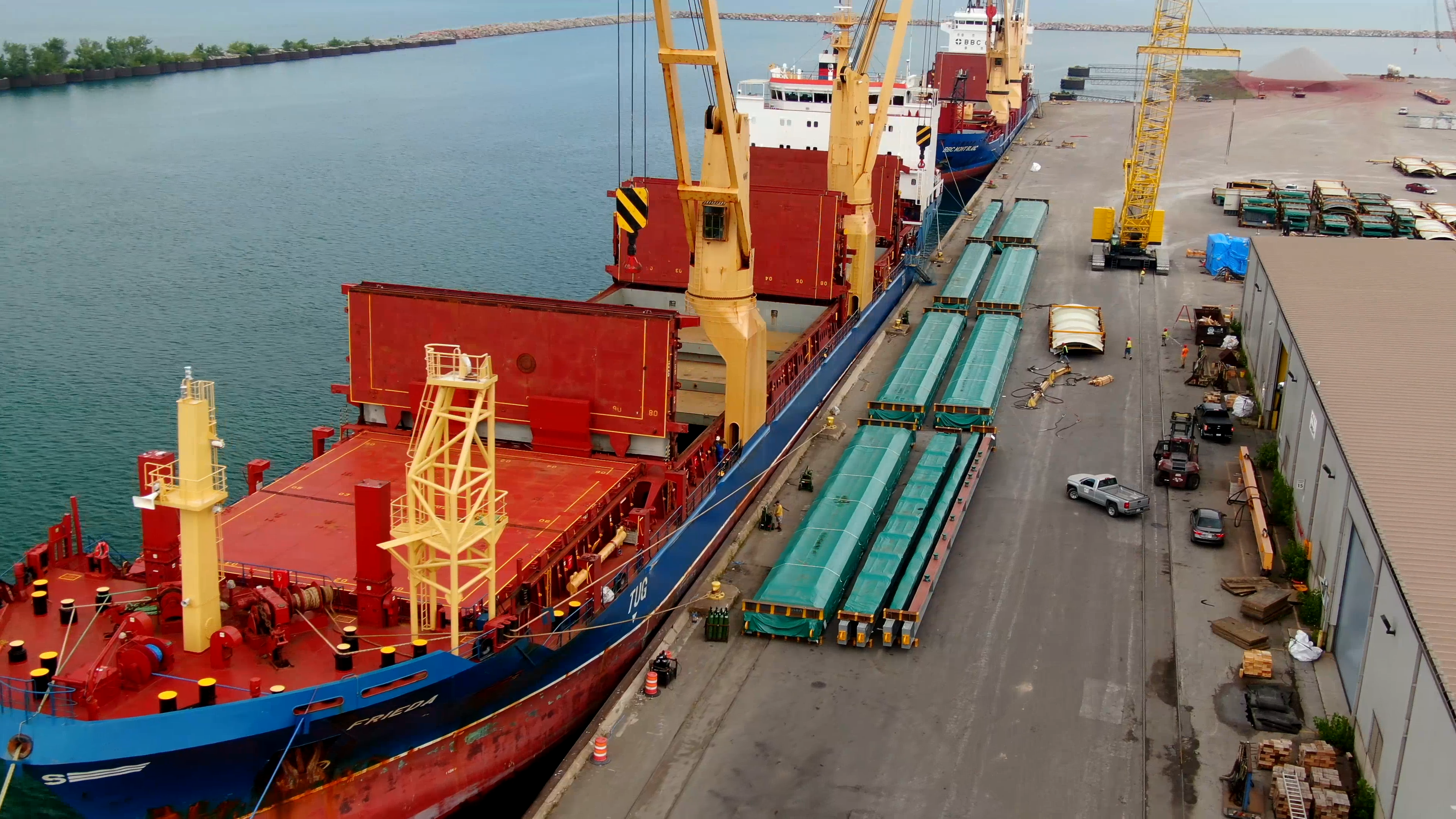
If you notice your packages arriving much faster than they did at the start of the pandemic, it isn’t just a minor coincidence – rather, it could be the Great Lakes shipping industry making a comeback after weathering the effects of COVID-19’s spread.
“(This) has been a bounce-back season from the COVID-induced lows of 2020,” said Jason Hron, director of communication and marketing for the Duluth Seaway Port Authority.
Approaching two years since Great Lakes Now’s initial reports on the pandemic’s immediate impact on the shipping industry, most ports have adjusted to the setbacks they once faced.
Shipping is a huge industry in the region, with the Great Lakes’ iconic freighters and ports from Duluth to Cleveland to Montreal supporting $35 billion in economic activity and more than 200,000 jobs.
And in the 2021 shipping season, more than 38 million metric tons of total cargo was shipped through the St. Lawrence Seaway, according to a report from the Great Lakes Seaway Partnership. Total cargo shipped increased by 1% from 2020, with a surge in particular categories like iron ore – 14.4% increase from 2020 – and general cargo – 72.98% increase from 2020.
As the 2022 shipping season approaches, the ports’ adjustments to the pandemic-related issues in part come from investments into port infrastructure that were made before the pandemic hit that are now coming to fruition, port administrators said.
Those investments have gone into infrastructure changes like expansions and new green technology.
“Infrastructure improvements have definitely spurred new and expanded business at Great Lakes ports over the past several years,” Hron said.
Since 2015, the Port of Duluth has invested $36 million into infrastructure improvements, which has allowed them to set multiple records in wind cargo freight tonnage.
In a recent press release, the Great Lakes Seaway Partnership, which comprises various maritime organizations within the region, reported on improvements from the 2021 shipping season. Compared to 2020, the Port of Cleveland reported a 69% increase in tonnage across its docks. The port also has undergone various infrastructure improvements, including the expansion of its iron ore tunnel and introduction of a new main gate at its general cargo facility.
“The 2022 Navigation Season is already shaping up to be a strong year for the Port of Cleveland,” David Gutheil, chief commercial officer for the Port of Cleveland, said in the release.
According to Eric Peace, director of operations and communications for the Lake Carriers’ Association, 2021 was a successful year for shipping in the entire Great Lakes region. The LCA is an organization representing the U.S.-flag Great Lakes fleet.
“There was an increase in shipping towards the end of last season,” Peace said. “And then, at the beginning of this season, we picked right back up and have been shipping quite a bit of raw materials for almost a year now.”
In the same Great Lakes Seaway Partnership press release, the Ports of Indiana-Burns Harbor stated that its international tonnage increased by 135% from 2020 to 2021.
“2021 was ripe for opportunities,” said port director Ryan McCoy. “We had several non-scheduled freight shipments that landed at just the right time. Our infrastructure was ready, and we were able to capture new projects. It was a banner year.”

A freighter on the Lake Michigan Ports of Indiana-Burns Harbor. Burns Harbor is one of the busiest ports in the Great Lakes region. (Photo Credit: Ports of Indiana – Burns Harbor)
New setbacks and ripple effects
But current payoffs also expose some of the limitations of these infrastructure improvements. While the changes have yielded positive results, the speed with which they can be put into action is a major flaw that many ports are struggling to face.
“You really can’t implement infrastructure improvements that quickly to see a large impact,” said Scott Simmons, general manager and port director for the Port of Buffalo and Gateway Trade Center. “Instead, we try to make certain that our equipment is working and running efficiently. We communicate very best we can with both the people doing the shipping and the people handling the cargo. We’re trying to help move things fast.”
Ripple effects from the start of the COVID-19 pandemic also remain a problem for many in the shipping industry. Supply chain failures, in one example, played a major role in increasing shipping costs.
“Container shipping is one area in which the Great Lakes region has seen significant impacts. Specifically, there’s currently a global strain on container supply and elevated costs to ship containers,” said Hron.
In addition to these supply chain disruptions, the labor shortage has also been a major player in the shipping industry’s battle against the pandemic. The water transportation industry – which includes Great Lakes shipping – faced a major drop in labor from just over 67,000 in January 2020 to just under 56,000 in January 2021, according to the U.S. Bureau of Labor Statistics. The industry has so far been unable to return to the employment levels it once saw prior to the pandemic, with just a slight increase to 57,000 in January 2022.
The labor shortage is exacerbated by the trend of aging workers in the industry, with 28.6% of workers in water transportation age 55 or older, also according to U.S. Bureau of Labor Statistics data.
“There’s a lack of mariners, and we’ve been dealing with it by trying to get younger folks involved with the maritime industry,” Peace said.
Watch Great Lakes Now‘s segment on what life is like on a Great Lakes freighter:
Looking ahead: How can the industry fully bounce back?
Many ports in the Great Lakes region have identified specific legislation that will further improve their conditions, including recent attempts to authorize a new Great Lakes icebreaker ship.
The Build Back Better Act, currently stalled, has a provision granting $350 million in funding for a new Great Lakes icebreaker for the U.S. Coast Guard. In late February, the Coast Guard Authorization Act of 2022 was introduced to the U.S. House Transportation and Infrastructure Committee, which also includes $350 million for a new icebreaker.
“An additional heavy icebreaker around the Great Lakes would prove extremely valuable for not only coastal communities, but also obviously for shipping and maintaining our maritime transportation system during the winter,” said Peace.
The new Soo Lock is another large-scale infrastructure project that the shipping industry has advocated for and which was fully funded by the U.S. Army Corps of Engineers in January. The Soo Locks allow ships to travel between Lake Superior and the lower Great Lakes. The new lock is estimated to be complete by 2030.
As the shipping season waits to start back up in late March, many ports are hoping that these changes will yield some positive change for the industry as a whole.
Catch more news on Great Lakes Now:
Stalled Ships: Shipping industry looks to infrastructure investments to boost demand
Sustainable Shipping: At the Port of Milwaukee the wind blows toward a greener future
Featured image: Freighter on the Great Lakes (Great Lakes Now Episode 1021)
1 Comment
-
Do you have the shipping schedule in and out of Marquette, MI?




